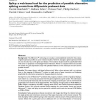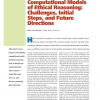935 search results - page 181 / 187 » A Framework for Obfuscated Interpretation |
CORR
2006
Springer
13 years 8 months ago
2006
Springer
We investigate here concept learning from incomplete examples. Our first purpose is to discuss to what extent logical learning settings have to be modified in order to cope with da...
CSDA
2006
13 years 8 months ago
2006
Numerical possibility distributions can encode special convex families of probability measures. The connection between possibility theory and probability theory is potentially fru...
BMCBI
2007
13 years 8 months ago
2007
Background: The Affymetrix™ technology is nowadays a well-established method for the analysis of gene expression profiles in cancer research studies. However, changes in gene ex...
EXPERT
2006
13 years 8 months ago
2006
on abstract principles that you can't easily apply in a formal, deductive fashion. So, the favorite tools of logicians and mathematicians, such as firstorder logic, aren'...
IJDAR
2006
13 years 8 months ago
2006
Evaluation of object detection algorithms is a non-trivial task: a detection result is usually evaluated by comparing the bounding box of the detected object with the bounding box...


